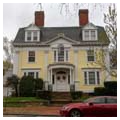Number 177 George Street is an exceptionally ebullient example of early Willsonian Colonial Revival among other near-contemporaneous works by his firm. The picturesque, asymmetrical massing left over from the Queen Anne Style has disappeared; the front is symmetrical and the motifs are exclusively colonial in derivation. But with what un-colonial exuberance of scale, invention, and combination! The ogee curve of the porch anticipates the somewhat more (but not overly) archaeological flavor of the multiplicity of ogee-curved gables and dormers of Willson's Taft House around the corner ( PR166), of one year later. The delight of the early Colonial Revival in such curved forms also appears in the pregnant bulge of another of those semicircular bowed spaces derived from the Federal period, here projecting from a side elevation.
To follow Willson's evolution from Queen Anne into Colonial through a neighborhood sequence, consider this chronology: PR139 (1886); PR167 (1888); this (1894); PR166 (1895). And finally (with the next entry), back to his Queen Anne, pre–Colonial Revival starting point.

























